Indulge Your Nucleus Accumbens.*
Listen to these twelve musical intervals to determine which ones appeal to you the most. For an explanation
of intervals, see the chart below. Click on an image to expand.
The Acutonics tuning forks have archetypal connotations, and these complex meanings are signified by the color of the fork. Each fork has a cosmic correlative (planets, planetoids, asteroids, the Sun, Moon, and Earth), meanings drawn from the spirit and wisdom traditions of both Eastern and Western medicine, medical astrology, mythology (Greek, Chinese, Egyptian, et al.), celestial and quantum mechanics, and Jungian psychology. Each fork also corresponds with parts of the anatomy and somatic processes.
*the brain’s pleasure center

Earth
Ohm fork: C#
Earth fork: G
six, half-steps = a diminished fifth
Ohm fork: C#
Earth fork: G
six, half-steps = a diminished fifth
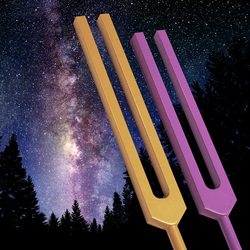
Zodiac
Ohm fork: C#
Zodiac fork: F
four, half-steps = a major third
Ohm fork: C#
Zodiac fork: F
four, half-steps = a major third
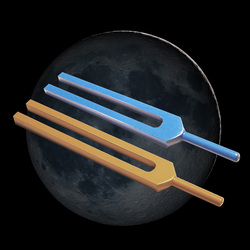
New Moon
Ohm fork: C#
Moon (blue) fork: G#
seven, half-steps = a perfect fifth
Ohm fork: C#
Moon (blue) fork: G#
seven, half-steps = a perfect fifth
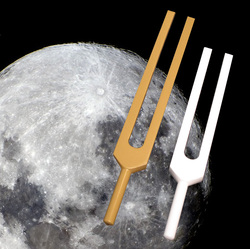
Full Moon
Ohm fork: C#
Moon (white) fork: A#
nine, half-steps = a major sixth
Ohm fork: C#
Moon (white) fork: A#
nine, half-steps = a major sixth
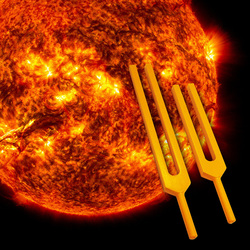
Sun
small Sun fork: B
large Sun fork: B
an octave
small Sun fork: B
large Sun fork: B
an octave
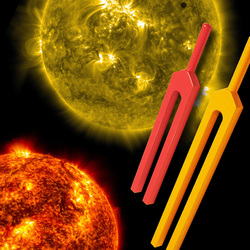
Sun/Venus
Sun fork: B
Venus fork: A
two, half-steps = a major second
Sun fork: B
Venus fork: A
two, half-steps = a major second

Mars/Venus
Mars fork: D
Venus fork: A
seven, half-steps = a perfect fifth
Mars fork: D
Venus fork: A
seven, half-steps = a perfect fifth

Chiron/Venus
Chiron fork: D#
Venus fork: A
eight, half-steps = an augmented fifth
Chiron fork: D#
Venus fork: A
eight, half-steps = an augmented fifth
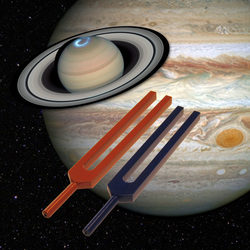
Saturn/Jupiter
Saturn fork: D
Jupiter fork: F#
four, half-steps = a major third
Saturn fork: D
Jupiter fork: F#
four, half-steps = a major third
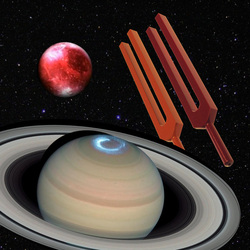
Saturn/Nibiru
Saturn fork: D
Nibiru fork: E
two, half-steps = a major second
Saturn fork: D
Nibiru fork: E
two, half-steps = a major second
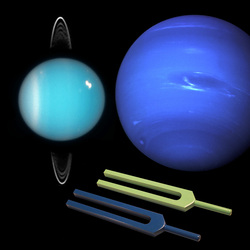
Uranus/Neptune
Uranus fork: G#
Neptune fork: G#
The two pitches are similar but not identical, creating a "beat" frequency effect.
Uranus fork: G#
Neptune fork: G#
The two pitches are similar but not identical, creating a "beat" frequency effect.
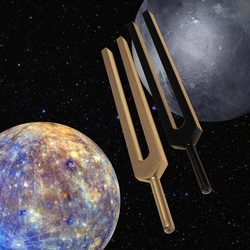
Mercury/Pluto
Mercury fork: C#
Pluto fork: C#
The two pitches are similar but not identical, creating a "beat" frequency effect.
Mercury fork: C#
Pluto fork: C#
The two pitches are similar but not identical, creating a "beat" frequency effect.
Intervals and half-steps
On a keyboard, intervals are measured in half-steps by counting from white key to black key to white key, etc. E.g., C to C# = one half-step. C# to D = one half-step. There are twelve half-steps in an octave.
A major second = two half-steps. C to D is a major second because it consists of two half-steps on the keyboard.
A major third = four half-steps. C to E is a major third.
A perfect fourth = five half-steps. C to F is a perfect fourth.
A perfect fifth = seven half-steps. C to G is a perfect fifth.
A major sixth = nine half-steps. C to A is a major sixth.
A major seventh = eleven half-steps. C to B is a major seventh.
A perfect eighth (or octave) = twelve half-steps. C to C is a perfect eighth.
On a keyboard, intervals are measured in half-steps by counting from white key to black key to white key, etc. E.g., C to C# = one half-step. C# to D = one half-step. There are twelve half-steps in an octave.
A major second = two half-steps. C to D is a major second because it consists of two half-steps on the keyboard.
A major third = four half-steps. C to E is a major third.
A perfect fourth = five half-steps. C to F is a perfect fourth.
A perfect fifth = seven half-steps. C to G is a perfect fifth.
A major sixth = nine half-steps. C to A is a major sixth.
A major seventh = eleven half-steps. C to B is a major seventh.
A perfect eighth (or octave) = twelve half-steps. C to C is a perfect eighth.
Music Makes Us
These are a few of the intervals used in Vibrational Sound Healing, and the recordings were made from the high frequency tuning forks used in treatments. From among the twelve sample intervals, which ones do you respond to the most? I like the major second (Sun/Venus and Saturn/Nibiru), which also happens to occur in the Happy Birthday song. While preference is important, it’s only part of the story.
George Leonard, a twentieth-century American writer and educator who wrote extensively about human potential, wrote: ‘Before we make music, music makes us… Music’s deep structure is identical with the deep structure of all things.” We all have emotional and physiological responses to sound, due in part to the profound connections we feel with pattern, structure, and order. Music’s deep structure resides in intervals and rhythms, signatures that correlate with emotion and stimulate a wide range of feelings within us. Aspects of our physiology are both analogous to and affected by sound intervals. (see blog entry Musical Intervals, Emotional Response, and Physiological Curiosities). Interval preferences, measurable with contemporary technologies, may reveal personal inner harmonies which then may provide clues to treating disharmonies and diseases.
According to Daniel Leviton, American cognitive psychologist, neuroscientist, and best-selling author, what we know for certain is that music co-evolved with the brain. It’s no surprise that sound activates the entire brain, and each individual brain has formed neural patterns that respond positively to certain musical intervals. Some say it’s from human voices we heard as a child: think of Brahms’ lullaby and the comforting minor third in which it’s composed or “Twinkle, Twinkle Little Star” with its perfect fifth. Others say these responses to sound come from the natural world, the sounds of birds, an ocean breaking on a rocky shore, a brisk wind blowing through pine trees. Regardless, we all respond to musical intervals with some predictability.
“Studies all agree that the musical intervals of the octave, the fifth, and the fourth are the most consonant, followed closely by the major sixth, major third; the tritone, minor seventh, major second, major seventh, and minor second are the least consonant. Remarkably, listeners of all ages, places, and historical periods tend to produce this same general consonance ordering, suggesting that it has a basis in some fundamental property of audition.”1
In tuning fork therapy, each interval has its therapeutic qualities and archetypal meanings that link to the long tradition of sound as a form of therapy. For example, a perfect third is thought to be opening, stimulating power and movement, thereby releasing stagnation and blockages. A perfect third is a powerful therapeutic force against pain. The major second, the interval I'm drawn to, promotes growth and contains the potential for movement beyond boundaries and limits. An octave evokes a response of calm and balance.
Recognizing that sound is “hidden” within all of us and operates on many levels, Vibrational Sound Healing protocols initiate energy shifts in clients experiencing physiological, emotional, psycho-spiritual, intergenerational, and cellular disharmonies. In consideration of this complexity, when faced with a healing challenge the important question is this: how do we determine the “why” of a client’s condition and then decide on a treatment protocol? A client’s disharmonies can be difficult to parse. In addition, sometimes protocols work for many people with similar problems, like stress, but other times problems can be opaque and intractable. Since no protocol can be designed in the absence of the client, and no single therapy works for all people all of the time, the challenge is to find the individual’s inner chord by trial and error, like an optician trying different lenses for optimal sight. Through both empirical methods and intuition, an experienced Vibrational Sound Healing professional learns how a person responds to sound and can judge whether a specific sound or interval has the desired therapeutic effect. Treatments are adjusted to suit the needs of the person.
1 From the Center for Cognitive Neuroscience, Duke University, 2005.
2 http://www.purveslab.net/research/explanation/sound/music.html
for further reading:
http://phenomena.nationalgeographic.com/2013/04/11/why-does-music-feel-so-good/
